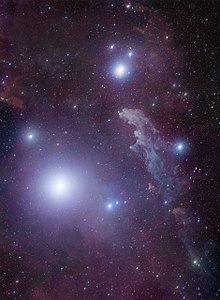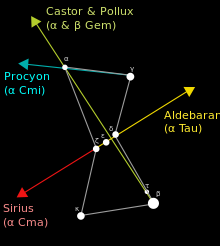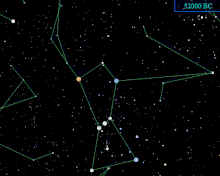| Observation data Epoch J2000.0 Equinox J2000.0 | |
|---|---|
| Constellation | Orion |
| Pronunciation | /ˈraɪdʒəl/ or /-ɡəl/ |
| A | |
| Right ascension | 05h 14m 32.27210s |
| Declination | −08° 12′ 05.8981″ |
| Apparent magnitude (V) | 0.13 (0.05 - 0.18) |
| BC | |
| Right ascension | 05h 14m 32.049s |
| Declination | −08° 12′ 14.78″ |
| Apparent magnitude (V) | 6.67[6] (7.6/7.6) |
| Characteristics | |
| A | |
| Evolutionary stage | Blue supergiant |
| Spectral type | B8 Ia |
| U−B color index | −0.66 |
| B−V color index | −0.03 |
| Variable type | Alpha Cygni |
| BC | |
| Evolutionary stage | Main sequence |
| Spectral type | B9V + B9V |
| Astrometry | |
| Radial velocity (Rv) | 17.8±0.4 km/s |
| Proper motion (μ) | RA: +1.31 mas/yr Dec.: +0.50 mas/yr |
| Parallax (π) | 3.78 ± 0.34 mas |
| Distance | 860 ± 80 ly (260 ± 20 pc) |
| Absolute magnitude (MV) | –7.84 |
| Orbit | |
| Primary | Ba |
| Companion | Bb |
| Period (P) | 9.860 days |
| Eccentricity (e) | 0.1 |
| Semi-amplitude (K1) (primary) | 25.0 km/s |
| Semi-amplitude (K2) (secondary) | 32.6 km/s |
| Orbit | |
| Primary | B |
| Companion | C |
| Period (P) | 63 yr |
| Details | |
| A | |
| Mass | 21±3 M☉ |
| Radius | 78.9±7.4 R☉ |
| Luminosity (bolometric) | 1.20+0.25 −0.21×105 L☉ |
| Surface gravity (log g) | 1.75±0.10 cgs |
| Temperature | 12100±150 K |
| Metallicity [Fe/H] | −0.06±0.10 dex |
| Rotational velocity (v sin i) | 25±3 km/s |
| Age | 8±1 Myr |
| Ba | |
| Mass | 3.84 M☉ |
| Bb | |
| Mass | 2.94 M☉ |
| C | |
| Mass | 3.84 M☉ |
| Other designations | |
| A: Rigel, Algebar, Elgebar, 19 Orionis, HD 34085, HR 1713, HIP 24436, SAO 131907, BD-08°1063, FK5 194 | |
| B: Rigel B, GCRV 3111, STF 688B, BU 555B | |
Rigel (/ˈraɪdʒəl,
Although appearing as a single star to the naked eye, Rigel is actually a multiple star system. The name Rigel strictly refers to the brightest component of this system. It is a massive blue-white supergiant estimated to be anywhere from 61,500 to 363,000 times as luminous as the Sun, depending on the method used to calculate its properties and assumptions about its distance, thought to be about 860 light-years (260 pc). Rigel has begun to exhaust the hydrogen in its core, causing the star to expand to over 70 times the Sun's radius. Its small intrinsic brightness changes are caused by pulsations and it is classified as an Alpha Cygni variable.
Rigel's brightest companion is itself a likely triple star system, separated from Rigel by 9.5″. Often referred to as Rigel B, it has a combined apparent magnitude of 6.7, but is still over 400 times fainter than the primary star and visible only with a telescope. Rigel B is a spectroscopic binary composed of the components Ba and Bb. It also has a very close visual companion, component C, of almost equal brightness to B, making the BC subsystem a triple star system.
Nomenclature
The name Rigel was likely first recorded in the Alfonsine Tables of 1252. It is derived from the Arabic name Rijl Jauzah al Yusrā, "the left leg (foot) of Jauzah" (i.e. rijl meaning "leg, foot"), which can be traced to the 10th century. "Jauzah" was a proper name of the Orion figure, an alternative Arabic name was رجل الجبار riǧl al-ǧabbār, "the foot of the great one", which is the source of the rarely used variant names Algebar or Elgebar. The Alphonsine Tables saw its name split into "Rigel" and "Algebar", with the note, et dicitur Algebar. Nominatur etiam Rigel. Alternate spellings from the 17th century include Regel by Italian astronomer Giovanni Battista Riccioli, Riglon by German astronomer Wilhelm Schickard, and Rigel Algeuze or Algibbar by English scholar Edmund Chilmead.
In 2016, the name Rigel was officially entered in the IAU Catalog of
Star Names for β Orionis A, the blue supergiant component visible to the
naked eye.
β Orionis (Latinized to Beta Orionis) is the star's Bayer designation, although it is usually the brightest star in Orion. Astronomer James B. Kaler
has speculated that perhaps Rigel was designated by Bayer during a rare
period where it was outshone by the variable star Betelgeuse, resulting
in the latter star being designated alpha and Rigel designated beta. Rigel is included in the General Catalogue of Variable Stars, but since it already has a Bayer designation, β Orionis, it has no separate variable star designation.
Observation
Rigel is the seventh-brightest star in the celestial sphere excluding the Sun—usually fainter than Capella, although both are slightly variable in brightness. Rigel is an irregular pulsating variable with a range in apparent magnitude from 0.05 to 0.18. Although Rigel has the Bayer designation "beta", it is almost always brighter than Alpha Orionis (Betelgeuse). Since 1943, the spectrum of this star has served as the spectral reference, for class B8Ia, by which other stars are classified. Rigel has a color index (B–V) of −0.06, meaning it appears slightly blue-white, almost white.
Culminating at midnight on 12 December, and at 9 pm on 24 January, Rigel is most visible in winter evenings in the northern hemisphere and summer in the southern. In the southern hemisphere, Rigel is the first bright star of Orion visible as the constellation rises. The star forms the starting vertex of the "Winter Hexagon", an asterism that includes Aldebaran, Capella, Pollux, Procyon, and Sirius. This formation is visible from most locations on Earth and is prominent in the night sky from December through March. In stellar navigation, Rigel is one of the most important navigation stars,
since it is bright, easily located and equatorial, which means it is
visible all around the world's oceans (the exception is the area within
8° of the North Pole).
Spectroscopy
The general spectral type of Rigel as B8 is well-established and it
has been used as a defining point of the spectral classification
sequence for supergiants. The overall spectrum is typical for a late B class star, with strong absorption lines of the hydrogen Balmer series together with neutral helium lines and some of heavier elements such as oxygen, calcium, and magnesium.
The luminosity class for B8 stars is determined from the strength and
narrowness of the hydrogen spectral lines, and Rigel is assigned to the bright supergiant class Ia.
As early as 1888, the radial velocity of Rigel, as determined from the Doppler shifts
of its spectral lines, was seen to vary. This was confirmed and
interpreted as a spectroscopic companion with a period of about 22 days. The radial velocity has since been measured to vary by about 10 km/s around a mean of 21.5 km/s.
In 1933, the Hα spectral line was seen to be unusually weak and shifted 0.1 nm towards shorter wavelengths, while there was a narrow emission spike about 1.5 nm to the long wavelength side of the main absorption line. This is now known as a P Cygni profile
after a star that shows this feature strongly in its spectrum. It is
associated with strong mass loss where there is simultaneously emission
from dense wind close to the star and absorption from circumstellar
material expanding away from the star.
The unusual Hα line profile has since been observed to vary
unpredictably: around a third of the time it is a normal absorption
line; about a quarter of the time it is a double-peaked line, that is an
absorption line with an emission core or an emission line with an
absorption core; about a quarter of the time it has a P Cygni profile;
most of the rest of the time the line has an inverse P Cygni profile,
where the emission component is on the short wavelength side of the
line; rarely there is a pure emission Hα line.
The line profile changes are interpreted as variations in the quantity
and velocity of material being expelled from the star. Occasional very
high velocity outflows are seen, and even more rarely infalling
material. The overall picture is one of large looping structures arising from the photosphere and driven by magnetic fields.
The variations in the spectrum have been reflected in published spectral classes, such as B8 Ia, B8 Iab, and B8 Iae.
Variability
Rigel
has been known to vary in brightness since at least 1930, although the
exact range and type of variability was unclear. Published results
showed variations of less than 0.1 magnitudes with no obvious period.
Observations over 18 nights in 1984 showed variations at red, blue, and
yellow wavelengths of up to 0.13 magnitudes on timescales of a few hours
to several days, but again no clear period. The colour index also varied but in general was not strongly correlated with the brightness variations.
From an analysis of Hipparcos satellite photometry, Rigel was identified as belonging to the Alpha Cygni class of variable star in 1998, which are defined as "non-radially pulsating supergiants of the Bep–AepIa spectral types". (The 'e' indicates it displays emission lines in the spectrum, while the 'p' means it has an unspecified spectral peculiarity.) It was added to the General Catalogue of Variable Stars in the following year in the 74th namelist of variable stars.
The Hipparcos photometry showed variations with a photographic
amplitude of 0.039 magnitudes and a possible period of 2.075 days.
Rigel was observed with the Canadian MOST
satellite for nearly 28 days in 2009. The light variations in this
supergiant star were at the milli-magnitude level. The gradual changes
in the flux highlights the presence of long-period pulsation modes in
the star.
Mass loss
By observing the Hα spectral line, in 2009 Chesneau and colleagues calculated the mass loss from Rigel to be (1.5±0.4)×10−7 solar masses per year (M☉/yr), around ten million times more than the mass loss from the Sun.
More detailed optical and K band infrared spectroscopic observations, together with VLTI interferometry, were taken from 2006 to 2010. Analysis of the Hα and Hγ spectral line profiles, and measurement of the regions producing the lines, show that the stellar wind
varies greatly in structure and strength. Loop and arm structures were
also detected within the wind. Calculations of mass loss from the Hγ
line give (9.4±0.9)×10−7 M☉/yr in 2006-7 and (7.6±1.1)×10−7 M☉/yr in 2009-10. Calculations using the Hα line give lower results, around 1.5×10−7 M☉/yr. The terminal wind velocity is 300 km·s−1.
Distance
Rigel and reflection nebula IC 2118 in Eridanus. Rigel B is not visible in the glare of the main star.
The distance to Rigel has been difficult to measure with any
accuracy, as its brightness is not easy to determine independently and
it is too distant for very accurate parallax
measurements. As it is both bright and moving through a region of
nebulosity, Rigel lights up several dust clouds in its vicinity, most
notably the 5°–long IC 2118 (the Witch Head Nebula), located at an angular separation of 2.5° from the star. These are thought to be about 40 light-years (12 parsecs) distant from the star itself.
For stars associated with this nebulosity, Kounkel and colleagues in a
2018 study gave a distance estimate of 949 ± 7 light-years (291 ± 2
parsecs).
Rigel has been classified as an outlying member of the Orion OB1 Association,
which is located at a distance of up to 1,600 light-years (500 parsecs)
from Earth. It has also been listed as a member of the poorly-defined Taurus-Orion R1 Association, somewhat closer at 1,200 light-years (360 parsecs). Rigel is thought to be considerably closer than most of the members of Orion OB1 and the Orion Nebula. Betelgeuse and Saiph lie at a similar distance as Rigel, although Betelgeuse is a runaway star with a complex history and might have originally formed in the main body of the association.
The revised 2007 Hipparcos reduction of Rigel's parallax gives a distance of 863 light-years (265 parsecs), with a margin of error of about 9%. A companion star to Rigel, usually considered to be physically associated and at the same distance, has a Gaia Data Release 2 parallax of 2.9186±0.0761 mas,
implying a distance around 1,100 light-years (340 parsecs). However,
the measurements for this object show a number of features suggesting
they may be unreliable, possibly because it is a close double star.
Stellar system
Rigel forms a multiple star system with up to five or six components. The blue supergiant primary has a visual companion
which is itself a likely a close triple star, plus a more distant
visual companion that may also form part of the multiple star system.
William Herschel discovered Rigel to be a visual double star on 1 October 1781, and it was catalogued as H II 33 (or H 2 33). Friedrich Georg Wilhelm von Struve first measured the relative position of the companion in 1822, cataloging the visual pair as Σ 668. The secondary star can be referred to as Rigel B or β Ori B. The angular separation of β Ori B from the primary star is 9.5 arc seconds to its south along position angle 204°. Although not particularly faint at visual magnitude
6.7, the overall difference in brightness from the primary (about 6.6
magnitudes or 440 times fainter) makes it a challenging target for
telescope apertures smaller than 15 cm (6 in).
At Rigel's estimated distance, β Ori B's projected separation from its primary is over 2,200 AU. Since its discovery, there has been no sign of orbital motion, although both stars share similar common proper motion. The pair would have a minimum orbital period of around 18,000 years. Gaia Data Release 2
(DR2) contains a somewhat unreliable parallax for β Ori B, placing it
at about 1,100 light-years (340 parsecs), further away than the
Hipparcos distance for Rigel, but similar to the Taurus-Orion R1
association. There is no parallax for Rigel in Gaia DR2. The Gaia DR2
proper motions for β Ori B and the Hipparcos proper motions for Rigel
are both small, although not quite the same.
Sherburne Wesley Burnham in 1871 suspected β Ori B to be double, and in 1878 resolved it into two nearly equal components. Their measured separation varies from less than 0.1" to nearly 0.2". In 2009, speckle interferometry showed two almost identical components separated by 0.124". The companion is designated as component C (β Ori C). Both stars have apparent visual magnitudes of 7.6. Their derived orbital period is 63 years.
β Ori B appears to be a double-lined spectroscopic binary system, which indicates that the individual absorption lines of both components is visible in the spectrum. It consists of two main sequence
stars that orbit each other every 9.86 days. These two stars do not
seem to correspond to the visual binary components B and C, so the BC
sub-system might be a triple, although the actual arrangement is
unclear.
In 1878, Burnham also found another nearby 15th magnitude star,
catalogued as component D (β Ori D), whose 2017 separation from Rigel
was 44.5″ almost due north at position angle of 1°,
although it is unclear whether it is physically related or a
coincidental alignment. Gaia DR2 finds it to be a 12th magnitude sunlike
star at approximately the same distance as Rigel.
Most likely to be an orange dwarf, this star would have an orbital
period of around 250,000 years, if it is part of the stellar system.
Another spectroscopic companion to Rigel has been reported on the basis of radial velocity
variations, and even an orbit calculated, but it is thought that the
star does not exist and the pulsations are intrinsic to Rigel itself.
Physical characteristics
Rigel's place at top center on the Hertzsprung-Russell diagram
Rigel is the most luminous star within 1,000 light-years of the Sun. Moravveji and colleagues calculate a luminosity for Rigel of 120,000 times that of the Sun. Its surface temperature is around 12,100 K. The interferometer-measured angular diameter of this star, after correction for limb darkening, is 2.75±0.01 mas. At its estimated distance, this yields a size of about 78.9 times the radius of the Sun (R☉).
Norbert Przybilla and colleagues assumed a distance of 1,170 ± 130
light-years (360 ± 40 parsecs). They calculated it to be around 218,000
times as luminous as the Sun, and have around 21±3 solar masses and 109±12 R☉.
A 2018 study using the Navy Precision Optical Interferometer measured the angular diameter of 2.606±0.009 mas, yielding the radius as 74.1+6.1
−7.3 R☉, and luminosity 61,515±11,486 times that of the Sun. Based on the Hipparcos distance of 780 light-years (240 parsecs) and an Orion OB1 association distance of 1,600 light-years (500 parsecs), the relative luminosity is calculated to be somewhere between 83,000 L☉ and 363,000 L☉
−7.3 R☉, and luminosity 61,515±11,486 times that of the Sun. Based on the Hipparcos distance of 780 light-years (240 parsecs) and an Orion OB1 association distance of 1,600 light-years (500 parsecs), the relative luminosity is calculated to be somewhere between 83,000 L☉ and 363,000 L☉
Rigel is a blue supergiant
that has exhausted burning the hydrogen fuel in its core and left the
main sequence, expanded, and brightened as it progresses across the Hertzsprung–Russell diagram. Puzzlingly, the pulsation properties of this star suggest it passed through the red supergiant phase, whereas the surface abundances indicate it evolved directly to a blue supergiant. Przybilla estimated that it has lost around 3 solar masses since beginning life as a star of 24±3 solar masses 7 to 9 million years ago. It is expected to eventually end its stellar life by exploding as a type II supernova from a red supergiant, in the process flinging out material that will serve to seed future generations of stars. It is one of the closest known potential supernova progenitors to Earth, and would be expected to have an apparent magnitude of around −11 at its peak.
Rigel's variability is complex and is caused by stellar pulsations similar to those of Deneb,
the prototype of the class of Alpha Cygni pulsating stars. The radial
velocity variations of Rigel prove that it simultaneously oscillates in
at least 19 non-radial modes with periods ranging from about 1.2 to 74
days.
While its pulsations are powered by the nuclear reactions in a
hydrogen-burning shell that is at least partially non-convective, the
star also burns helium in its core.
Visual double star β Ori B appears to be a close triple star
system (Rigel Ba, Bb, and C), but due to their proximity, little is
known about their individual intrinsic properties. All seem to be near
equally hot B class main sequence stars that weigh between 3 to 4 M☉.
Etymology and cultural significance
In ancient Egypt, Rigel is thought to have been called Seba-en-Sah Sb3-n-S3ḥ, which means Star of Sah. Rigel is thought to denote either Orion's knee or (as its name suggests) his foot; with the nearby star Beta Eridani marking the footstool. Rigel is presumably the star known as "Aurvandil's toe" in Norse mythology.
In Chinese, 參宿 (Shēn Sù), meaning Three Stars (asterism), refers to an asterism consisting of Rigel, Alnitak, Alnilam, Mintaka, Betelgeuse, Bellatrix and Saiph. Consequently, Rigel are known as 參宿七 (Shēn Sù qī, the Seventh Star of Three Stars).
In Japan, the Minamoto or Genji clan chose Rigel and its white color as its symbol, calling the star Genji-boshi (源氏星), while the Taira or Heike clan adopted Betelgeuse and its red color. The two powerful families fought a legendary war; the stars were seen as facing each other off and only kept apart by Orion's Belt. Rigel was also known as Gin-waki, (銀脇), "the Silver (Star) beside (Mitsu-boshi)".
Rigel was known as Yerrerdet-kurrk to the Wotjobaluk koori of southeastern Australia, and held to be the mother-in-law of Totyerguil (Altair). The distance between them signified the taboo preventing a man from approaching his mother-in-law. The indigenous Boorong people of northwestern Victoria named Rigel as Collowgullouric Warepil. The Wardaman people of northern Australia know Rigel as the Red Kangaroo Leader Unumburrgu and chief conductor of ceremonies in a songline when Orion is high in the sky. Eridanus,
the river, marks a line of stars in the sky leading to it, and the
other stars of Orion are his ceremonial tools and entourage. Betelgeuse
is Ya-jungin "Owl Eyes Flicking", watching the ceremonies.
The Māori people named Rigel as Puanga; this was said to be a daughter of Rehua (Antares), the chief of all stars. Its heliacal rising also presaged the appearance of Matariki (the Pleiades) in the dawn sky which marked the Māori New Year in late May or early June. The Moriori people of the Chatham Islands, as well as some Maori groups in New Zealand, marked the start of their New Year with Rigel rather than the Pleiades. Puaka was a local variant used in the South Island.
In the Caribbean, Rigel represented the severed leg of the folkloric figure Trois Rois, himself represented by the three stars of Orion's Belt. The leg had been severed with a cutlass by the maiden Bįhi (Sirius). The Lacandon people of southern Mexico knew it as tunsel ("little woodpecker").
In modern culture
Rigel and escort under attack
The MS Rigel was originally a Norwegian ship, built in Copenhagen in 1924. It was requisitioned by the Germans during the World War II and sunk in 1944 while being used to transport prisoners of war. Two US Navy ships have borne the name USS Rigel after the star.
The SSM-N-6 Rigel, named after the star, was a cruise missile program for the US Navy that was cancelled in 1953 before reaching deployment.
The Rigel Skerries are a chain of small islands in Antarctica, renamed after originally being called Utskjera. They were given their current name as Rigel was used as an astrofix. Mount Rigel, also in Antarctica, is also named after the star.
The name Rigel, or reference to the star itself, occurs frequently in fictional works.


















